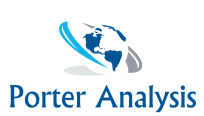Air Liquide is a French multinational which supplies industrial gases to various industries. It was founded in 1902 and now operates over 80 countries in the world (Air Liquide, 2020). It is considered to be a world leader in industrial gas and related services. It provides services to various industries including electronics manufacturers, the health industry, and the chemical industry. It provides services to larger industries such as chemical, metal, pharmaceuticals, automobile makers, refining, and energy. It provides services to electronics makers such as semiconductor, flat panel & photovoltaic makers all over the world (Air Liquide, 2020). In healthcare, it includes hospitals, home healthcare, and hygiene-related special ingredients. Porter’s five forces model is a useful tool to identify threats and opportunities faced by Air Liquide in the industrial gases industry in the world.
Competitive Rivalry in the Market
The industrial gas industry is concentrated and few companies control the major of market share. It boosts the competition within the industry to be the market leader. The industry is growing steadily at the moment. It provides opportunities for companies to compete for a better share. The main rival of Air Liquide is Air Products & Chemicals and Linde plc. The Irish origin multinational Linde Plc is considered as the market leader. It generated consolidates sales of $14.9 billion in 2018 (Linde, 2020). Air Products & Chemicals is an American based rival. It reported the annual revenue of $ $8,930.2M (Fortune, 2019). Air Liquide posted a net profit of $2,494M with a revenue of $24,796.60M (Fortune, 2019). The competition within the industry is growing rapidly. The overall industry is expected to grow by around 4% by 2021.
Threat of substitutes
The threat of substitution is low, it is because of the two main reasons. The industry scale Air Liquide operates is concentrated and there are very few alternative products available at the moment. The alternative products are way too expensive and there operational cost it too high with a low-profit margin. The quality of the product and switching to a new product is a barrier for a substitute. Air Liquide can stay ahead in business by keeping its product quality better than available in the market. It also needs to come up with a new innovative product to keep its market share. The overall threat of substitutes is low in the industrial gas industry.
Threat of new Entrants
The industrial gas industry is regulated strictly by the regulator around the world. The government policies and licensing requirements must be fulfilled before the production. The higher capital investment in production and innovation makes it difficult for startups. The startup needs to invest money in research and development of new products to compete with established companies. It makes it harder for startups to sustain in the market. Air Liquide holds the major share in the market. They produce the product at a much cheaper price due to the scale of their economy. Air Liquide has around 5 innovative centers in 3 continents for research and development purposes (Air Liquide, 2020). The threat of the new entrant in industrial gas is relatively low.
Bargaining Power of Buyers
The buyers of industrial gases are usually integrated industries such as oil and refining, healthcare, electronics maker, and chemical industry. Air Liquide provides products to nearly every industry in the world. The Bargaining Power of Buyer is high if the buyers are large, they are ably to switch easily to another supplier who maybe are in numbers (Slater & Olson, 2002). The industry is very saturated and there are unlimited buyers of industrial gases in the market. Product differentiation in the industry is very visible. There are several products available in the industry. Product quality and differentiation can attract the buyer. Air Liquide produces products for every industry which provides its edge in contract negotiating. The bargaining power of the buyer is relatively low against Air Liquide.
Bargaining Power of Supplier
The supplier in the industry is the one who provides the production equipment for industry. The industry is concentrated but multiple suppliers are available. The exploration and production equipment is expensive. The companies need their services for regular maintenance and up-gradation after purchasing the equipment. The companies don’t want to lose their equipment. Companies may want to switch to another supplier because the market is full of an alternative supplier. They can’t due to the cost of switching is too high and it takes precious time. The majority of suppliers are future integrated with the companies. Suppliers want to keep their financial future secure. These suppliers provide services across the industry. The supplier, in that case, holds moderate power in negotiating the deal.
References
Air Liquide. (2020) At a glance. Available at: https://www.airliquide.com/group/glance
Air Liquide. (2020) Profile. Available at: https://www.airliquide.com/group/profile
Air Liquide. (2020) Research development. Available at: https://www.airliquide.com/group/research-development
Fortune. (2019) Global 500. Available at: https://fortune.com/fortune500/2019/air-products-chemicals/
Fortune. (2019) Global 500. Available at: https://fortune.com/global500/2019/air-liquide/
Linde. (2020). Investors. Financial reports. Available at: https://investors.linde.com/-/media/linde/investors/documents/full-year-financial-reports/2018-annual-report-to-shareholders.pdf?la=en&rev=46454aa02ffd45c6b0bec1e291381ded
Slater, Stanley & Olson, Eric. (2002). A fresh look at industry and market analysis. Business Horizons. 45. 15-22. 10.1016/S0007-6813(02)80005-2.
